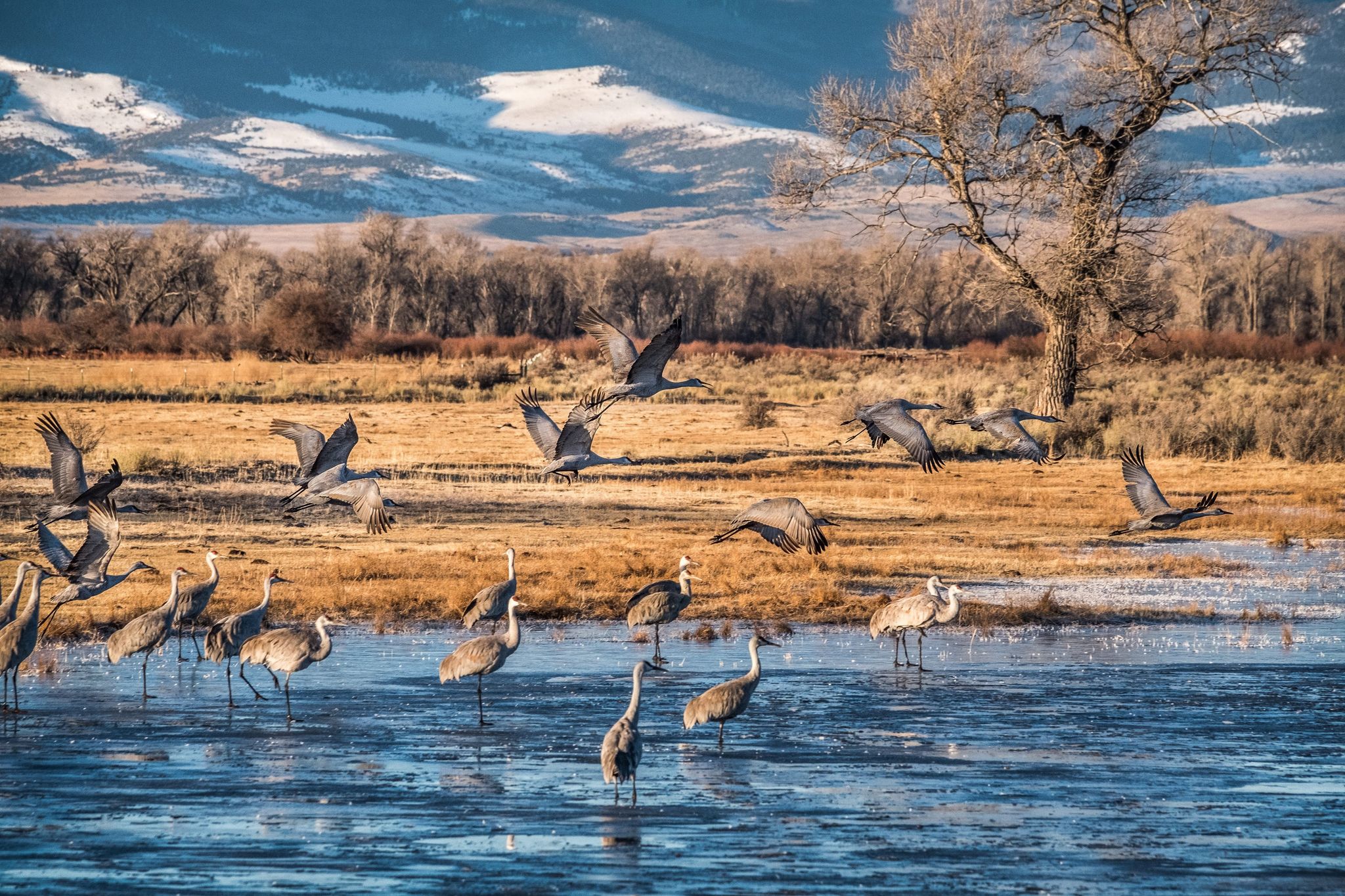The Sandhill Crane Migration is upon us, and the SLV is just a couple of weeks away from seeing flocks of cranes in numbers up to 20,000 lining the skies and scattered across the wetlands around the Valley. Travelers and locals near and far come to witness this awe striking event, many hoping to catch captivating photos of the large birds. Knowing where to be and when to be there is half of the battle, but fear not as Visit Alamosa sought out local photographers that have the answers to those questions, along with some tips and tricks sure to guide you on the right path!
The crane migration in the San Luis Valley generally begins mid February, peaks the first two weeks of March and most of the crane will move out by the first week in April. Travelers will have the opportunity to view the cranes on more than 100,000 acres of wetlands across the Valley! Though the wetlands are hotspots for viewing, the birds can be found in crop fields, along the banks of Home Lake, out in the cattle fields and even standing on the road sides. It can be hard to narrow down the perfect viewing spot, but all of the information one needs can be found here on the Visit Alamosa website. Explore the Monte Vista, Alamosa, and Baca National Wildlife Refuges to map out the best locations.
When it comes to crane watching and photography, it seems that the early bird gets the worm! Valley resident and local photographer for 15 years, Yael Defaye suggests getting out early. He states “The cranes will be closer in the early morning before the bus arrives. The bus has a tendency to push the cranes away from everyone. Bring something to stay warm, the early mornings can be cold!” Yael got his best shots at the Monte Vista National Wildlife Refuge on the south and east sides. When it comes to taking your photos, he recommends that you “Set your camera to sport mode if you can. It will let your camera know it needs a fast shutter speed. Faster the shutter speed, the faster the camera freezes the action and gets the subject without any motion blur. A long telephoto is always better to bring the cranes closer. Avoid the 2x add-on in front of your lens. It would make you lose a lot of details in your pictures. A long telephoto will require a faster shutter than usual, except if you have stabilization in the lens or camera.”
Kim Marquez, another Valley resident and local photographer offers some insight, stating “I recommend shooting in the morning within an hour after sunrise or an hour before sunset for the most ideal lighting and dramatic clouds as a backdrop when shooting in the sky. However, any time of day can be great!” With 10 years of experience shooting professional photos, she shared some tips saying “I recommend turning up the shutter speed to 1/800 if photographing them while flying without a tripod. A lens that shoots 300mm or more is great to get really up close shots, but my photos were shot on a 70-200mm and still effective.” Kim is sure to remind photographers to “not be afraid to experiment and take lots of shots!” Kim captured her striking images at the Monte Vista National Wildlife Refuge on highway 15 South. This refuge is known to be the hub of crane photography and many of the best images are captured in this area. The Monte Vista Crane Festival website published a brochure laying out the best locations on the refuge and can be found here!
As Monte Vista celebrates 40 years of The Monte Vista Crane Festival, we hope travelers and residents alike take advantage of this year's migration and take a chance at shooting the perfect shot of these magnificent birds! Every year the festival hosts a nature art and crafts fair at the Ski Hi complex hosting a large selection of vendors! The event boasts an endless amount of tours, workshops, and talks for the duration of the festival. An event schedule can be found here.
Looking for a little more information on the Monte Vista Wildlife refuge wetlands and other wetlands of the Valley? Local photographer, videographer, and owner of In Light of Nature Photography filmed and put together a gorgeous, detailed video of the various areas! You can find the video on his websitee here.
From all of us at Visit Alamosa, happy crane watching!







